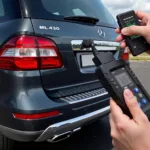OBD2 Test Mode 14, often referred to as emissions readiness or diagnostic trouble code (DTC) status, is a crucial aspect of your vehicle’s onboard diagnostics system. It provides valuable insights into the health and functionality of your car’s emissions control system. Whether you’re a car enthusiast or a professional mechanic, understanding OBD2 Test Mode 14 can help you diagnose emissions-related issues and ensure your vehicle is running smoothly and within legal emissions standards.
What is OBD2 Test Mode 14?
OBD2 Test Mode 14 allows you to access the status of various emissions-related monitors within your vehicle’s engine control unit (ECU). These monitors continuously evaluate the performance of different components and systems that contribute to emissions control. By accessing Test Mode 14, you can determine if these monitors have completed their diagnostic tests and whether any faults have been detected.
How OBD2 Test Mode 14 Works
Your car’s ECU runs specific tests, known as drive cycles, to evaluate the functionality of the emissions system. Each monitor in Test Mode 14 corresponds to a particular system or component. When a monitor completes its diagnostic cycle without detecting any issues, it is considered “ready” or “complete.” Conversely, if a problem is identified during the test, the corresponding monitor will indicate a “not ready” or “incomplete” status and store a diagnostic trouble code (DTC) in the ECU’s memory.
Accessing and Interpreting OBD2 Test Mode 14 Data
Accessing OBD2 Test Mode 14 typically requires a specialized OBD2 scanner or code reader that supports this functionality. Once connected to your vehicle’s OBD2 port, you can navigate to the Test Mode 14 section.
The data displayed in Test Mode 14 will vary depending on the vehicle make and model, but it generally includes a list of emissions monitors and their respective status. You might encounter terms like:
- Complete: The monitor has completed its diagnostic test, and no issues were found.
- Incomplete: The monitor has not yet finished its test cycle. This could be due to insufficient driving conditions or a recent reset of the ECU.
- Not Ready: The monitor has detected a potential problem, and a DTC has been stored.
In addition to the monitor status, Test Mode 14 might also display pending or confirmed DTCs. These codes provide more specific information about the nature of the emissions-related problem.
Common Uses of OBD2 Test Mode 14
OBD2 Test Mode 14 plays a vital role in various automotive applications, including:
- Emissions Testing: Many jurisdictions require vehicles to undergo periodic emissions testing. Test Mode 14 data helps technicians determine if a vehicle’s emissions system is functioning correctly and meets regulatory standards.
- Vehicle Diagnostics: Mechanics use Test Mode 14 to diagnose emissions-related problems. By analyzing the monitor status and DTCs, they can identify faulty components or systems.
- DIY Car Maintenance: Car enthusiasts can use OBD2 Test Mode 14 to monitor their vehicle’s emissions system health and potentially catch issues early on.
Tips for Using OBD2 Test Mode 14
- Consult Your Vehicle’s Repair Manual: Refer to your car’s specific repair manual for detailed information about the emissions monitors and their corresponding systems.
- Complete Drive Cycles: If you recently cleared DTCs or reset the ECU, you’ll need to complete specific drive cycles to allow the monitors to run their tests. These cycles involve various driving conditions and can be found in your vehicle’s repair manual.
- Seek Professional Help When Needed: While OBD2 Test Mode 14 can provide valuable information, it’s essential to consult a qualified mechanic if you encounter persistent emissions-related issues or are unsure how to interpret the data.
 Mechanic Using OBD2 Scanner for Diagnostics
Mechanic Using OBD2 Scanner for Diagnostics
Conclusion
OBD2 Test Mode 14 is an indispensable tool for anyone looking to understand and maintain their vehicle’s emissions control system. By providing insights into the status of emissions monitors and diagnostic trouble codes, Test Mode 14 empowers car owners and mechanics to diagnose and address emissions-related issues effectively. Regular checks and proper interpretation of Test Mode 14 data can contribute to a healthier running vehicle and a cleaner environment.
For more information on specific OBD2 scanners and their capabilities, explore the f30 obd2 scanner and discover the best tool for your needs.
